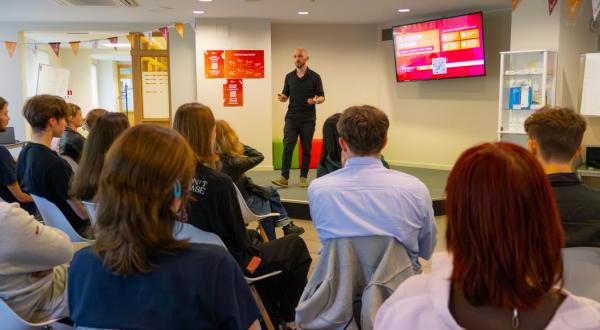Asst Prof. Toms Pulmanis: E-Studies Offer A Lot of New Opportunities
Toms Pulmanis, Vice-Dean and Assistant Professor at the Rīga Stradiņš University (RSU) Faculty of Public Health and Social Welfare, admits that the pace with which the in-person study process had to be replaced by remote learning posed a challenge. There are, however, other challenges that students, lecturers and RSU employees have had to face during these times of changes and anxiety too.

How has the Faculty of Public Health and Social Welfare implemented remote learning?
The transition happened so fast – we had to find solutions quickly, acquire and use the new technologies and reorient our e-study environment. We were, however, lucky to have so many talented and creative co-workers, especially our colleagues in the IT Department who responded very quickly. The transition process was also made much easier thanks to that fact that we were not starting from scratch since RSU has been using the e-study environment for a long time already.
We would be in a much more difficult situation if there had not been a base on which to implement these changes to the study process in transitioning from in-person to remote learning.
I am grateful for how quickly my colleagues in the IT Department could react to our needs. This included training for our lecturers. All of these factors made the process easier, but you could certainly not say that it has been simple. It is very important that RSU works like a united, supportive team at this time.
Is it right to say that the main challenge was, and is, the speed at which changes had to be introduced?
It's not just about the speed.
One of the challenges has been to reorient lecturers. Working in the e-studies environment is much more complicated than working face-to-face with a student.
Lecturers not only have to get acquainted with the new technology, but also be able to use it effectively. From my own experience, and that of several colleagues, I can say that remote lectures and classes require much more from a lecturer. It is continuous communication – you have to check how many people have logged on, who is having difficulties, whether they are still connected and whether their mics and cameras are on, give presentations, constantly give feedback, adjust tasks, test new settings and help your colleagues among other things. It is not easy.
The major challenge in the near future will be to organise final exams, as all exams and the defence of final papers will have to take place remotely. Student placements will be another major challenge. We are currently looking into solutions regarding how and when placements could be carried out.
What are some good examples can you give of different forms of remote learning?
The forms can be very different. Long before this situation, when lectures were still held on-site, several study courses had already started utilising video lectures that students could watch at any time. We are currently using Zoom a lot.
In my opinion Zoom has greater potential than video lectures, as Zoom allows you to organise interactive classes that do not differ much from in-person lectures and occasionally might even be more exciting for students.
There is an opportunity to communicate – students can not only listen, but also get involved, ask questions, give presentations and comment one another’s work. Lecturers can also show and explain their presentations, or other materials. Communication is no longer just one-way as it is in case of recorded video lectures.
The chat function can also be used for larger groups – a lecturer can ask a question and students can answer directly. It is possible to divide students into groups and assign different tasks and then join individual groups. This technology offers a wide range of possibilities.

What do students say about distance learning? What feedback have you heard?
I can’t speak on behalf of all students, but I think that most of them are satisfied with these solutions. I have only heard positive feedback from my own classes. Students have appreciated being able to participate in classes virtually from their homes. Classes no longer require travel, which is convenient for students as it saves time and, of course, protects their health in the current circumstances.
On a faculty level I have noticed that there have been far fewer applications for exmatriculation and for academic leave due to family circumstances during this period of emergency. Maybe students have more time to study, or maybe they find these solutions more convenient as they can now combine studying with home life. We must be cautious with our optimism, however, because the crisis can affect students financially. Let's hope it ends soon.
I would like to sincerely thank our faculty’s lecturers, study programme directors and all departments for their work and endurance. We are working, new solutions are emerging all the time, and I know that we will be successful.
Related news
 Develop your business skills and bring ideas to life with the B-Space incubation programmeFor RSU Employees, For High School Students, For Students, Innovation
Develop your business skills and bring ideas to life with the B-Space incubation programmeFor RSU Employees, For High School Students, For Students, Innovation


